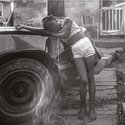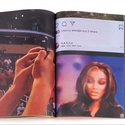DAZED Thursday September 22, 2022
Roxanne Lowit, whose work joyfully captured the glamorous elite of fashion, died on September 13 at age 80, notes WWD. Born in New York in 1965, Lowit grew up between the Bronx and Long Island before studying textile design at FIT. There, she met fashion illustrator Antonio Lopez, who gave her an Instamatic 110 camera and introduced her to the beau monde of downtown NYC, notes Dazed. Fashion editor Annie Flanders of SoHo News assigned Lowit to cover Paris Fashion Week and her life took a new direction. Among her best known images: a 1990 shot of supermodels Naomi Campbell, Christy Turlington and Linda Evangelista in bathtub at a private party thrown by Gianni Versace.
Read the full Story >>
British Journal of Photography Thursday September 22, 2022
During several road trips between 1983 and 1989, photographer Baldwin Lee documented African Americans living, playing, loving and surviving, often amid the grinding poverty in the southern United States. The images have finally been published, four decades after they were made, in the new monograph Baldwin Lee. The British Journal of Photography says the collection of 88 black-and-white images is a “mesmerizing study of characters and their conditions," including Lee himself, a first-generation Chinese American raised in New York. Read the full Story >>
PetaPixel Thursday September 22, 2022
Not long ago the new big thing was 360° photos, VR, and 3D visuals, but in 2022 it’s all about AI-generated images, notes Stock Photo Secrets. The new technology “is gaining traction in the stock media industry, posing new challenges and opening gaps for new software tools to fill,” declares the website. PetaPixel agrees, noting that AI images generated by machines are for sale en-masse on stock photo websites such as Shutterstock, iStock, and Adobe Stock. A search on Shutterstock with the term “AI-Generated” returned 18,850 results, reports PP.
Read the full Story >>
Art in America Thursday September 22, 2022
What’s the new big thing in art? Print! In the past two decades, notes Art in America, a number of companies have made print-on-demand technologies available to the masses. Xlibris—which in 2000 the New York Times described as producing “exceptionally ugly” but occasionally “exceptional” books—appeared in 1997, with Lulu and Blurb following in 2002 and 2005, respectively. “Print was not dying, as some predicted. Far from it: print remained a subject of keen obsession for various producers,” notes writer Lucy Ives. Read the full Story >>




